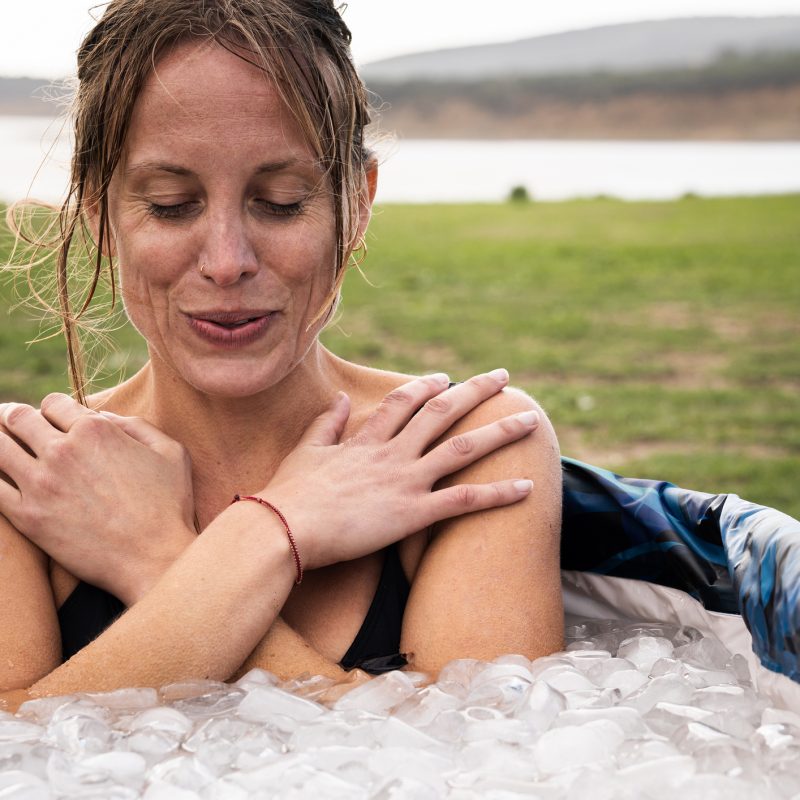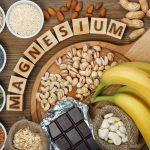
Cold water immersion (CWI) has recently gained popularity as a means of reducing post-exercise muscle stiffness, lessening fatigue, decreasing exercise-induced muscle damage (EIMD), and facilitating post-exercise recovery. However, experts continue to disagree on whether CWI functions positively or negatively, as its exact mechanisms remain somewhat elusive. In this article, we will review the collection of available research and highlight the various methods (timing, temperature, frequency, etc.) of CWI and its proposed cellular mechanisms. As the debate continues, coaches and personal trainers may wish to carefully consider an athlete’s particular needs before suggesting they take the ice plunge.
Brief History of Cryotherapy
Recovery from exercise, always a crucial aspect for athletes to consider, proves especially important with repeated bouts of exercise. In competitive situations, where athletes compete numerous times over several days, enhancing recovery may confer a competitive advantage. Forty years ago, following personal observations of Professor Toshiro Yamauchi (who recognized that the combination of cold and physical exercise proved quite beneficial for patients affected by rheumatoid arthritis), whole-body cryotherapy entered the fringes of clinical practice.
Today, whole-body cryotherapy figures prominently in sports medicine, particularly for athletes’ post-competition season and/or following injuries. The principle behind cryotherapy lies in its withdrawal of heat, brought about by reductions in core and tissue temperatures and alterations in blood flow. Recent studies confirmed the treatment’s anti-inflammatory, anti-analgesic, and anti-oxidant effects by highlighting the underlying physiological responses.
Happenings Below the Surface
In many individuals, water immersion may cause beneficial post-exercise physiological changes in the body, such as intracellular–intravascular fluid shift, reduction of muscle edema, decrease in creatine kinase (CK) activity, and increased cardiac output (which enhances blood flow, nutrient distribution, and waste transportation). In addition, regular users of cryotherapy report an added psychological benefit, reducing the fatigue that accompanies elite-level workouts.
Does Cold Water Immersion Mimic Active Recovery?
During exercise, fluid from the blood gets projected into the working muscles due to an increase in the mean arterial pressure; this, in turn, increases the muscle volume and decreases the blood plasma fraction. Active recovery reduces this exercise-induced edema and, with an associated increase in blood flow, may also elevate the metabolism of substrates produced during exercise. Cold-water immersion appears to elicit a similar physiological response, without the athlete needing to expend any additional energy. When immersed, hydrostatic pressure acts on the body’s fluid within the immersed region. Fluid from the extravascular space now moves into the vascular compartment, reducing exercise-induced increase in muscle volume while simultaneously attenuating soft tissue inflammation. The blood volume increase gets redistributed to increase the cardiac preload, stroke volume, cardiac output, and blood flow through the body. The cardiac output increases in relation to the depth of immersion, potentially increasing by as much as 102% during neck-down, full-body immersions.
Exposure to cryotherapy appears to mimic some of the modalities of exercise, particularly the expression of myokines, leading experts to liken CWI to a form of active recovery. The term “myokines” encompasses peptides responsible for mediating energy supply in relation to acute bouts of exercise. The body utilizes myokines in muscle proliferation, differentiation, and regeneration, even independent of exercise. During and following exercise, myokines create signals within the muscle, thereby facilitating muscle–organ “crosstalk” to the brain, adipose tissue, bone, liver, gut, pancreas, and other vital organs. From a biochemical point of view, whole-body cryotherapy may not always bring about appreciable modifications, but often enough the final clinical analyses reveal a satisfactory uptick in terms of attenuating pain/stiffness, stress, and post-exercise recovery.
Specialized Chambers
Immediately after exercise, individuals immerse themselves in cold‐water baths, which can vary greatly, from custom-built temperature-controlled spas to large containers filled with water and ice. Research indicates large variations in the CWI protocols in terms of the length of time for immersion, water temperature, and the volume of body parts immersed. In one example, elite athletes in Australia participated in 3 immersion cycles, each 1 minute in ice water (5 degrees Centigrade) followed by one minute out, immediately upon completion of their exercise sessions. However, other clinical studies report success with immersion of up to 15 minutes, with water temperature up to 15 degrees Centigrade.
Some coaches take this practice to new heights. In whole-body immersion, the athlete wears a minimum of clothing: a bathing suit, socks, clogs, a headband, and a surgical mask (to avoid direct exhalation of humid air). They enter a chamber set at −60°C, where they stay for about 30 seconds, during which the body acclimates to the cold. Then, the athlete transitions into a cryochamber, set anywhere from −110° to −140°C, where they remain for no more than 3 min. The absolute necessity of removing/drying off any remaining sweat on the athlete’s body before entry avoids the risk of skin burning and potential necrosis.
Protocol Design
As mentioned above, much debate still exists with regard to the optimal temperature, session length, and number of sessions to ensure the best outcome. Most scientists agree on the crucial aspect of maintaining a constant temperature between two consecutive treatments. As expected, the cryochamber door opening as well as the subject permanence within the chamber will increase the temperature and reduce therapeutic effectiveness; allowing 2 minutes to pass between consecutive treatments would allow temperature recovery to remain at therapeutic levels.
While scant and small in sample size, some research does exist that points to how many sessions of immersion prove sufficient to elicit beneficial post-exercise effects. One research paper suggested 6 treatments; two more studies looked at the effectiveness of a single cryotherapy exposure; a final study reported data culled from 3 sessions. Collectively, experts felt that an athlete would need at least 20 consecutive sessions for evaluation data to prove effective, with 30 sessions most likely the optimum.
Research Data Seems Promising
Currently, the possible mechanisms postulated for the use of cold water/ice immersion therapy post exercise include the following ~
- With intense exercise comes some microtrauma and tears in the affected/targeted muscle fibers. This muscle damage will stimulate muscle cell activity (hypertrophy in the long term) and help in the repair and strengthening of the muscle. This also accounts for delayed onset pain and soreness (DOMS), which often presents 12–72 hours post-exercise. Ice baths help alleviate DOMS.
- Since an ice bath will cause constriction of blood vessels, experts feel that this mechanism helps with the flushing of waste products, such as lactic acid, out of the affected tissue.
- With the cold temperature, athletes experience a reduction in metabolism, which may cause a slowing down of the physiological processes.
- The cold temperature will reduce swelling and tissue breakdown.
- Ice water immersion may have the ability to shift lactic acid.
Effects of Ice Bath Immersion on Post-Workout Lactic Acid
Regardless of the sport, all bodies tend to produce lactate as a result of heavy training and/or intense physical competition. The amount produced, however, depends largely on the duration and intensity of the exercise as well as the length of the recovery interval. The body’s ability to clear lactate during a recovery phase relies on the working muscles to remove, tolerate, and buffer H+ as expeditiously as possible. While some elite athletes report success with a combination of hot and cold immersions, scientists agree that the mechanism by which active recovery promotes lactate removal remains largely unclear. This highly complex process hinges on a range of factors ~
- blood flow to the immediate area(s)
- chemical buffering
- movement of lactate from muscle tissues to the bloodstream
- lactate conversion to pyruvate in the liver, muscle, and heart
Like so many controversial topics in the science-fitness realm, this too will require many more studies in the future before we have all the answers.
The Other Side of the Coin
As we often find in scientific research, not all the effects of immersion have proven dramatically positive or beneficial. One research study compared athletes who underwent either cold-water immersion or room temperature baths following exercise sessions. The lead researcher concluded that increased artery diameter and hyperthermia seemed transient, specifically myofiber regeneration, muscle hypertrophy, and improved blood flow. Cooling attenuated these temperature-dependent processes and actually proved disadvantageous for training. Another study revealed the total ineffectiveness of ice baths at lessening the markers of DOMS.
In a study where elite cyclists underwent either ice water immersion or served as a control, even the briefest period of cold-water exposure invoked significant physiological effects that could impair cycling performance — maximum power declined by 13.7% versus 4.7% in the control group, and maximum heart rates decreased by 8.1% versus the control group’s 2.4%. Finally, subjects immersed from the neck down in a 19°C water bath, following half an hour of exercise on a treadmill at 80% MHR, displayed a significant decrease in their isometric hand grip strength.
If the athlete times their CWI inaccurately, the sudden exposure to cold can potentially slow down muscle/performance gains. One study revealed that exposing muscles too soon to cold temperatures like those in an ice bath may potentially limit the activation of key signaling pathways responsible for muscle protein synthesis. If a serious strength-training athlete concludes their workout with an immediate plunge into icy waters, they could slow down their expected growth in lean muscle tissue; however, this practice will not inhibit growth altogether.
Cold-water immersion during recovery from resistance-type exercise reduces myofibrillar protein synthesis rates and, as such, probably impairs muscle conditioning. Researchers feel that this information translates to the possibility that CWI attenuates the acute changes in satellite cell numbers and activity of kinases that regulate muscle hypertrophy; this, in turn, may lead to smaller long-term training gains in muscle strength and hypertrophy.
Take-home Message
The behaviors and practices in which athletes engage following their exercise/training/competition endeavors can potentially affect their muscle recovery as well as future sports performance. Coaches and personal trainers do advocate for the importance of an after-exercise recovery plan. Some typical recommendations include the following ~
- Sufficient rest to allow time for natural recovery to occur
- Gentle stretching that facilitates a faster recovery of muscle tissue
- A gradual cool-down period, as opposed to stopping immediately and abruptly
- A proper, balanced diet
- Adequate fluid replacement
- Appropriate massage
This list sometimes includes alternating hot and cold baths as well as total body immersion in cryotherapy chambers and below-the-neck ice bath immersion. As mentioned above, given the decided lack of absolute evidence with these therapies, further investigative research will hopefully reveal the optimal hot to cold time ratios, the appropriate mode of contrast treatment, the duration of treatments, and the optimum water temperature. Only then can we ascertain the true efficacy of this suggested process. While CWI has great appeal as a holistic approach to recovery, individuals who use strength training to improve athletic performance, recover from injury, or maintain their health might wish to reconsider whether to use cold water immersion as an adjuvant to their training.
References
https://pmc.ncbi.nlm.nih.gov/articles/PMC9896520/
https://pmc.ncbi.nlm.nih.gov/articles/PMC5411446/
https://pmc.ncbi.nlm.nih.gov/articles/PMC9012715/
https://pmc.ncbi.nlm.nih.gov/articles/PMC6492480/
https://pmc.ncbi.nlm.nih.gov/articles/PMC2938508/
https://pmc.ncbi.nlm.nih.gov/articles/PMC4603811/
https://pmc.ncbi.nlm.nih.gov/articles/PMC8826325/
https://www.brassmonkey.co/en-us/blogs/journal/does-cold-immersion-ruin-your-gains
https://pmc.ncbi.nlm.nih.gov/articles/PMC4594298/






